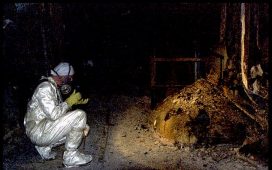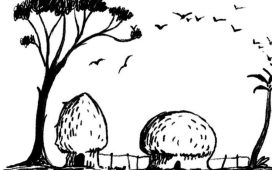Bronze Age Britons were infected with intestinal parasites caught thanks to their diet of raw fish, frogs and molluscs, a study of 3,000-year-old faeces has revealed.
Researchers from the University of Cambridge found that prehistoric settlers living in the freshwater marshes of The Fens were infected by intestinal worms.
They believe these parasites were caught because the villagers foraged for food in the stagnant lakes and waterways around their homes.
The Bronze Age settlement at Must Farm, located near modern-day Peterborough, consisted of wooden houses built on stilts above the water.
Wooden causeways connected islands in the marsh, while dugout canoes were used by the prehistoric settlers to travel along water channels.
Scroll down for video

Bronze Age Britons were infected with intestinal parasites caught thanks to their diet of raw fish, frogs and molluscs, a study of 3,000-year-old faeces has revealed. Pictured, fish tapeworm eggs unearthed from the Must Farm site
The village — first discovered in 1999 and hailed as ‘Britain’s Pompeii’ after an excavation in 2016 — burnt down in a catastrophic fire around 3,000 years ago.
Yet artefacts from the houses survived and were preserved in mud below the waterline of the marsh — including clothes, food and jewellery.
Archaeologist Piers Mitchell of the University Cambridge and colleagues have now added the discovery of waterlogged ‘coprolites’ — preserved pieces of human faeces — to these findings.
Researchers used state-of-the-art microscopes to detect ancient parasite eggs within the faeces and the surrounding sediments.
The revolting discoveries are important, the team explained, because very little is known about the intestinal diseases of Bronze Age Britain.
The single previous study of this topic — which concentrated on a farming village in Somerset — had found evidence of infection with both roundworm and whipworm, two parasites that are spread through the contamination of food by human faeces.
The ancient excrement from the Anglian marshes, however, told a different story.

Researchers from the University of Cambridge found that prehistoric settlers living in the freshwater marshes of The Fens were infected by intestinal worms. Pictured, the remains of the Must Farm site, which is located near present-day Peterborough
‘We have found the earliest evidence for fish tapeworm, Echinostoma worm, and giant kidney worm in Britain,’ said Dr Mitchell.
‘These parasites are spread by eating raw aquatic animals such as fish, amphibians and molluscs.’
‘Living over slow-moving water may have protected the inhabitants from some parasites, but put them at risk of others if they ate fish or frogs.’
Dr Mitchell explained that the because the settlers disposed of both animal and human waste into the surrounding waters, they were likely protected from faecal pollution directly reaching their food.
This would have spared them from the roundworm infections that plagued the Somerset site and other Bronze Age settlements known from across Europe.
However, the reed-populated waters of the fens would have been quite stagnant, Dr Mitchell said, causing waste to accumulate in the channels around the village.
Researchers believe that this probably provided ‘fertile ground’ for other parasites to infect the local wildlife and — when such animals were eaten raw or improperly cooked — allowed the infection to spread to the human residents.

The Bronze Age settlement at Must Farm consisted of wooden houses built on stilts above the water. They believe the parasites were caught because the villagers foraged for food in the stagnant lakes and waterways around their homes
‘The dumping of excrement into the freshwater channel in which the settlement was built, and consumption of aquatic organisms from the surrounding area, created an ideal nexus for infection,’ said biological anthropologist Marissa Ledger.
She said that fish tapeworms can reach up to 32.8 feet (10 metres) in length and live in humans by coiling up inside the intestines — with heavy infection having the potential to lead to anaemia.
Giant kidney worms, meanwhile, can reach up to 3.3 feet (1 metre) in length. They gradually destroy the host’s kidney as they grow, leading to the organ’s failure.
Echinostoma worms are much smaller, at up to 0.39 inches (1 centimetre) in length, yet infection can lead to an inflammation of the intestinal lining.

Archaeologists work on a scaffold platform assembled above Must Farm’s ‘structure 1’
‘As writing was only introduced to Britain centuries later, with the Romans, these people were unable to record what happened to them during their lives,’ explained Ms Ledger.
‘This research enables us for the first time to clearly understand the infectious diseases experienced by prehistoric people living in the Fens.’
The Cambridge team worked with organic chemists from the University of Bristol to determine whether the coprolites excavated from around the houses were human or animal. While some were human, others were from dogs.
‘Both humans and dogs were infected by similar parasitic worms, which suggests the humans were sharing their food or leftovers with their dogs,’ added Ms Ledger.
Other parasites that infect animals were also found at the site, including pig whipworm and Capillaria worm, which are believed to have originated from the consumption of the animal intestines of farmed or hunted animals.
These probably did not cause humans any harm, however.

The Must Farm Quarry site revealed the internal and external structure of a house during the excavation. Archaeologists encountered upright poles that used to support the building’s walls and roof, wall panels, collapsed roof beams and a row of poles arranged for a fence
The researchers compared their latest findings with previous studies on ancient parasites from both the Bronze Age and Neolithic — and determined that Must Farm fits the trend of fewer parasite species being found at Bronze Age sites.
‘Our study fits with the broader pattern of a shrinking of the parasite ecosystem through time,’ said Dr Mitchell.
‘Changes in diet, sanitation and human–animal relationships over millennia have affected rates of parasitic infection.’
However, he noted that infections from the same fish tapeworm found at Must Farm have recently seen a resurgence thanks to the popularity of such foods as ceviche, smoked salmon and sushi.
‘We now need to study other sites in prehistoric Britain where people lived different lifestyles, to help us understand how our ancestors’ way of life affected their risk of developing infectious diseases,’ Dr Mitchell added.
The full findings of the study were published in the journal Parasitology.














